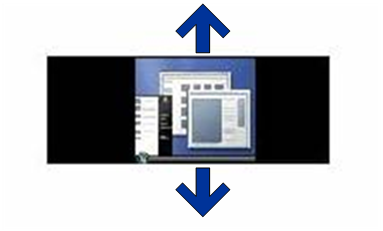Scaling the desktop image
This topic applies only to Windows 7 and later, and Windows Server 2008 R2 and later versions of the Windows operating system.
How scaling works
A caller can use the SetDisplayConfig Connecting and Configuring Displays (CCD) function to scale the desktop image to the monitor:
If the desktop and monitor use the same resolution, SetDisplayConfig is not required to scale the desktop image to the monitor. This SetDisplayConfig operation is known as identity scaling.
If the desktop and monitor resolution are different, SetDisplayConfig applies one of the following types of scaling. The monitor resolution is defined by the DISPLAYCONFIG_TARGET_MODE structure.
Centered scaling
Centered scaling is a mode in which the desktop is displayed on the monitor without any scaling at all. When SetDisplayConfig applies centered scaling, black bands might be visible above and below the desktop. The following figure shows centered scaling.

Stretched scaling
Stretched scaling is a mode in which the desktop is horizontally and vertically stretched on the monitor to ensure that the entire display is used. When SetDisplayConfig applies stretched scaling, no black bands are visible above and below the desktop. However, the desktop might appear distorted. The following figure shows stretched scaling.

Aspect-Ratio-Preserving Stretched
Aspect-ratio-preserving stretched scaling is a mode in which the desktop is stretched horizontally and vertically as much as possible while maintaining the aspect ratio. When SetDisplayConfig applies aspect-ratio-preserving stretched scaling, black bands might be visible either above and below or left and right of the desktop. However, black bands cannot be visible both above and below and left and right of the desktop. Because users are expected to prefer this type of scaling, SetDisplayConfig applies this type of scaling as the default. The following figure shows aspect-ratio-preserving stretched scaling.

Scaling depends on the source and target modes that are used for a path. In addition, the caller can call SetDisplayConfig without specifying the target mode information (that is, setting the modeInfoArray parameter is optional and can be set to NULL). This means that the caller cannot typically predict if SetDisplayConfig must perform any scaling. Furthermore, no API exists to get the full list of scaling types that the graphics adapter supports. The EnumDisplaySettings Win32 function returns DMDFO_DEFAULT in the dmDisplayFixedOutput member of the DEVMODE structure that the lpDevMode parameter points to when the caller requests the Windows 7 scaling types.
The scaling that a caller passes to SetDisplayConfig is a scaling intent rather than an explicit request to perform a scaling operation. If scaling is required (for example, source and target resolutions differ), SetDisplayConfig uses the scaling that the caller supplies. If the supplied scaling is not supported, SetDisplayConfig uses the graphics adapter's default scaling. When the source and target resolutions that the caller passes to SetDisplayConfig are the same, SetDisplayConfig always sets identity scaling.
Scaling requests
The following table shows the different SetDisplayConfig scaling requests, and identifies the abbreviated nomenclature used in the tables found in the sub-sections below. See DISPLAYCONFIG_SCALING for definitions of the DISPLAYCONFIG_SCALING_XXX values.
| Scaling request | Abbreviated nomenclature used in below tables |
|---|---|
| DISPLAYCONFIG_SCALING_IDENTITY | DC_IDENTITY |
| DISPLAYCONFIG_SCALING_CENTERED | DC_CENTERED |
| DISPLAYCONFIG_SCALING_STRETCHED | DC_STRETCHED |
| DISPLAYCONFIG_SCALING_ASPECTRATIOCENTEREDMAX | DC_ASPECTRATIOCENTEREDMAX |
| DISPLAYCONFIG_SCALING_CUSTOM | DC_CUSTOM |
| DISPLAYCONFIG_SCALING_PREFERRED | DC_PREFERRED |
| The adapter default scaling value. Currently, on tablet systems, the default is stretched. On non-tablet systems with graphics adapters that support the Windows Display Driver Model (WDDM), the default is defined by the driver. On non-tablet systems with graphics adapters that support WDDM with features new for Windows 7, the default is DC_ASPECTRATIOCENTEREDMAX. | AdapterDefault |
| The scaling value from the database for the current connected monitors | DatabaseValue |
SetDisplayConfig scaling requests
The following table shows the values that are saved in the database and the values that are actually set, where:
- "Set (same)" and "Store (same)" are the set and store values when the resultant source mode and target mode have the same resolution
- "Set (different)" and "Store (different)" are the set and store values when the resultant source mode and target mode have different resolutions
| Scaling flag passed to SetDisplayConfig | Set (same) | Store (same) | Set (different) | Set (different) |
|---|---|---|---|---|
| DC_IDENTITY current config not in Db | DC_IDENTITY | AdapterDefault | AdapterDefault | AdapterDefault |
| DC_IDENTITY current config in Db | DC_IDENTITY | DatabaseValue | DatabaseValue | DatabaseValue |
| DC_CENTERED | DC_IDENTITY | DC_CENTERED | DC_CENTERED | DC_CENTERED |
| DC_STRETCHED | DC_IDENTITY | DC_STRETCHED | DC_STRETCHED | DC_STRETCHED |
| DC_ASPECTRATIOCENTEREDMAX on WDDM with Windows 7 features driver | DC_IDENTITY | DC_ASPRATIOMAX | DC_ASPRATIOMAX | DC_ASPRATIOMAX |
| DC_ASPECTRATIOCENTEREDMAX on WDDM driver | DC_IDENTITY | AdapterDefault | AdapterDefault | AdapterDefault |
| DC_CUSTOM on WDDM with Windows 7 features driver that does support custom scaling on the path | DC_CUSTOM | DC_CUSTOM | DC_CUSTOM | DC_CUSTOM |
| DC_CUSTOM on WDDM with Windows 7 features driver that does not support custom scaling on the path | DC_IDENTITY | AdapterDefault | AdapterDefault | AdapterDefault |
| DC_CUSTOM on WDDM driver | DC_IDENTITY | AdapterDefault | AdapterDefault | AdapterDefault |
| DC_PREFERRED current config not in Db | DC_IDENTITY | AdapterDefault | AdapterDefault | AdapterDefault |
| DC_PREFERRED current config in Db | DC_IDENTITY | DatabaseValue | DatabaseValue | DatabaseValue |
Legacy ChangeDisplaySettingsEx scaling requests
The following table shows how the scaling that a caller can pass to the legacy ChangeDisplaySettingsEx API maps to the scaling set, where:
- "Set (same)" and "Store (same)" are the set and store values when the resultant source mode and target mode have the same resolution
- "Set (different)" and "Store (different)" are the set and store values when the resultant source mode and target mode have different resolutions
| Scaling flag passed to ChangeDisplaySettingsEx | Set (same) | Store (same) | Set (different) | Set (different) |
|---|---|---|---|---|
| DMDFO_DEFAULT with current config not in CCD database | DC_IDENTITY | AdapterDefault | AdapterDefault | AdapterDefault |
| DMDFO_DEFAULT with current config in CCD database | DC_IDENTITY | DatabaseValue | DatabaseValue | DatabaseValue |
| DMDFO_STRETCH | DC_IDENTITY | DC_STRETCHED | DC_STRETCHED | DC_STRETCHED |
| DMDFO_CENTER | DC_IDENTITY | DC_CENTERED | DC_CENTERED | DC_CENTERED |
| DM_DISPLAYFIXEDOUTPUT not set, current config not in CCD database | DC_IDENTITY | AdapterDefault | AdapterDefault | AdapterDefault |
| DM_DISPLAYFIXEDOUTPUT not set, current config in CCD database | DC_IDENTITY | DatabaseValue | DatabaseValue | DatabaseValue |
Legacy EnumDisplaySettings scaling translation
The following table shows how display configuration scaling is translated and returned from EnumDisplaySettings.
| Current active scaling | GDI scaling values returned from legacy EnumDisplaySettings(ENUM_CURRENT_SETTINGS) |
|---|---|
| DC_IDENTITY | DMDFO_DEFAULT |
| DC_CENTERED | DMDFO_CENTER |
| DC_STRETCHED | DMDFO_STRETCH |
| DC_ASPRATIOMAX | DMDFO_DEFAULT |
| DC_CUSTOM | DMDFO_DEFAULT |
| DC_PREFERRED | DMDFO_DEFAULT |
DirectX games and scaling
Microsoft DirectX 9L and earlier runtimes require that applications always call the ChangeDisplaySettingsEx function without DM_DISPLAYFIXEDOUTPUT set in the dmFields member of the DEVMODE structure that the lpDevMode parameter points to. DirectX 10 and later runtimes allow applications to choose the scaling that those applications pass to ChangeDisplaySettingsEx. The following table shows the mapping of scaling values to scaling flags that are passed to ChangeDisplaySettingsEx.
| DXGI flip chain scaling value | Scaling flags that are passed to ChangeDisplaySettingsEx |
|---|---|
| DXGI_MODE_SCALING_UNSPECIFIED | DMDFO_DEFAULT, DMDFO_CENTER, or DMDFO_STRETCH. The scaling that applications use depends on several factors, which include the current desktop scaling and the mode list that the driver exposes. |
| DXGI_MODE_SCALING_CENTERED | DMDFO_CENTER |
| DXGI_MODE_SCALING_STRETCHED | DMDFO_STRETCH |
By using this information in combination with the preceding scaling tables, you can determine the expected scaling from a DirectX application.